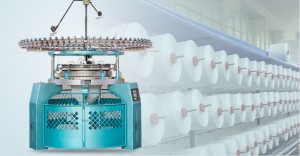Single knitting machine only uses bottom dial needle and needle leaf to knit. Single knitting machine is classified into plain machine, French terry machine, towel machine, messenger wire machine, automatic plain machine and jacquard machine.

1.Plain machine
Plain machine is used to knit plain textiles such as plain and strip jersey. Cooperating with tarn tsui, it can knit plated jersey. Equipped with corner angles and stitch, the machine can knit pique, lacoste, inter loop. New type plain machine has four level corner angles which can arrange needle with different heights. Cooperating with needles and closed die corner angles, the machine can knit jacquard textiles.
2.French terry machine
The structure of French terry machine is particular for its special corner angles. French terry machine can be only used to knit French terry and pique French terry. Changing corner angles and acerola ring, the machine can knit plain cloth.
3.Towel machine
Towel machine and cropping machine belong to the same type. However, they are different from each other strictly. The differences between towel machine and normal plain machine are needle leaf and yarn guide.
4.Messenger wire machine
Messenger wire machine is a new type knitting machine that plain machine is added with messenger wire equipment. It can also be used for knitting normal plain cloth.
5.Automatic plain machine
Automatic plain machine is classified into computer automatic plain machine and mechanical automatic plain machine in further. The machine is used to knit across cloth whose cycle length and color length are infinitely long in theory. The reason why automatic plain machine can knit separation distance decided by modules is that four finger exits on every yarn tsui and the finger is connect with yarn count with different colors. Cooperating with the chosen color on finger, the machine can control color variation between lines. Every yarn has only four fingers. For that the machine only can knit combination of four colors or less.
6.Jacquard machine:
Jacquard machine can knit different patterns by using two colors or more. In general, jacquard machine utilizes flower disc or drum to sending needles. Otherwise, computer jacquard machine has already appeared. The pattern data is saved in disk. Then put the disc into the computer on knitting machine. Computer control knitting.